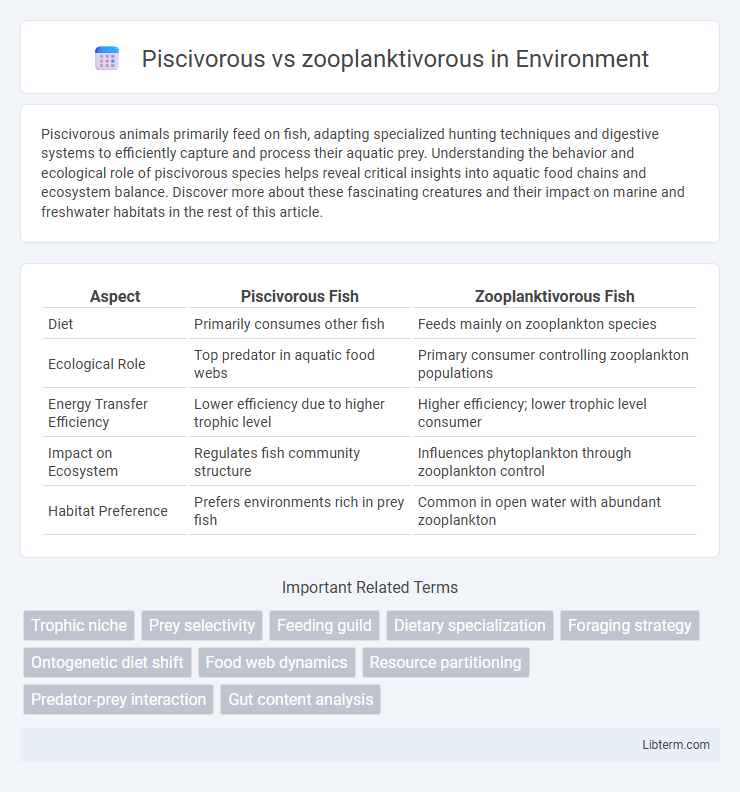Piscivorous animals primarily feed on fish, adapting specialized hunting techniques and digestive systems to efficiently capture and process their aquatic prey. Understanding the behavior and ecological role of piscivorous species helps reveal critical insights into aquatic food chains and ecosystem balance. Discover more about these fascinating creatures and their impact on marine and freshwater habitats in the rest of this article.
Table of Comparison
| Aspect | Piscivorous Fish | Zooplanktivorous Fish |
|---|---|---|
| Diet | Primarily consumes other fish | Feeds mainly on zooplankton species |
| Ecological Role | Top predator in aquatic food webs | Primary consumer controlling zooplankton populations |
| Energy Transfer Efficiency | Lower efficiency due to higher trophic level | Higher efficiency; lower trophic level consumer |
| Impact on Ecosystem | Regulates fish community structure | Influences phytoplankton through zooplankton control |
| Habitat Preference | Prefers environments rich in prey fish | Common in open water with abundant zooplankton |
Introduction to Piscivorous and Zooplanktivorous Diets
Piscivorous diets consist primarily of fish, targeting larger prey with specialized hunting adaptations, while zooplanktivorous diets rely on small, drifting zooplankton as the main food source. Piscivorous species often exhibit traits such as sharp teeth and agile swimming for catching fast-moving prey, whereas zooplanktivorous species have filtering mechanisms to efficiently capture microscopic organisms in water columns. Understanding these dietary strategies reveals key ecological roles and energy transfer pathways in aquatic ecosystems.
Definitions: Piscivorous and Zooplanktivorous Organisms
Piscivorous organisms primarily consume other fish as their main food source, often occupying higher trophic levels within aquatic food webs. Zooplanktivorous organisms feed predominantly on zooplankton, microscopic animals drifting in water columns, playing a crucial role in transferring energy from primary producers to higher trophic levels. Understanding the distinctions between piscivorous and zooplanktivorous feeding strategies is essential for studying aquatic ecosystem dynamics and trophic interactions.
Evolutionary Adaptations for Diet Specialization
Piscivorous fish have evolved sharp teeth, streamlined bodies, and enhanced sensory systems to effectively capture and consume other fish, optimizing predation efficiency. Zooplanktivorous species display adaptations such as finely branched gill rakers and specialized filtering mechanisms to efficiently sieve plankton from water. These evolutionary traits facilitate niche differentiation by minimizing dietary competition and maximizing resource utilization within aquatic ecosystems.
Morphological Differences Between Piscivores and Zooplanktivores
Piscivorous fish possess larger, more robust jaws with sharp teeth designed for capturing and consuming other fish, while zooplanktivorous fish exhibit smaller mouths and specialized gill rakers adapted for filtering tiny planktonic organisms. Morphological differences extend to body shape, with piscivores often having streamlined bodies for rapid pursuit, contrasting the more compact and maneuverable forms of zooplanktivores. These adaptations reflect their distinct feeding strategies and ecological niches within aquatic environments.
Habitat Preferences and Ecological Niches
Piscivorous fish predominantly inhabit open waters or structured environments like reefs where larger prey fish are abundant, enabling them to occupy top predator roles in aquatic food webs. Zooplanktivorous species prefer pelagic zones with high plankton density, often forming large schools in nutrient-rich waters to maximize feeding efficiency on microscopic zooplankton. These habitat preferences drive distinct ecological niches, with piscivores controlling fish population dynamics and zooplanktivores influencing plankton community structure and nutrient cycling.
Feeding Strategies and Prey Capture Techniques
Piscivorous fish employ ambush or pursuit predation strategies, relying on speed, sharp teeth, and powerful jaws to capture and consume other fish. Zooplanktivorous species utilize filter feeding or suction techniques, often swimming with open mouths and specialized gill rakers to efficiently trap microscopic zooplankton from the water column. These distinct feeding strategies optimize energy intake by targeting prey of varying sizes and mobility within aquatic ecosystems.
Role in Aquatic Food Webs
Piscivorous fish, as top predators, regulate populations of smaller fish and maintain ecosystem stability by preventing overgrazing on zooplankton and phytoplankton. Zooplanktivorous fish consume zooplankton, serving as a critical link between primary producers and higher trophic levels, facilitating energy transfer in aquatic food webs. The balance between piscivorous and zooplanktivorous species shapes nutrient cycling and influences community structure and biodiversity in aquatic environments.
Impact on Ecosystem Dynamics
Piscivorous fish, by preying on other fish species, regulate population sizes and promote biodiversity through trophic cascades, influencing nutrient cycling and habitat structure. Zooplanktivorous fish, feeding on zooplankton, control plankton populations and affect water clarity and primary productivity, impacting nutrient availability and algal bloom dynamics. The balance between piscivorous and zooplanktivorous fish shapes ecosystem stability and energy flow in aquatic food webs.
Case Studies: Representative Species
Case studies of piscivorous species like barracudas (Sphyraena spp.) reveal highly specialized hunting tactics that maximize fish prey capture, enhancing energy intake efficiency. In contrast, zooplanktivorous species such as the blackchin tilapia (Sarotherodon melanotheron) exhibit filter-feeding adaptations facilitating the consumption of microscopic zooplankton. Comparative analysis of these representative species underscores divergent ecological niches and feeding mechanisms fundamental to aquatic food webs.
Conservation Implications and Management Strategies
Piscivorous fish, which primarily consume other fish, often influence trophic cascades and ecosystem stability, necessitating management strategies that protect top predators to maintain balanced aquatic food webs. Zooplanktivorous fish feed on zooplankton, playing a crucial role in controlling plankton populations and water quality, requiring conservation efforts that preserve plankton habitats and water clarity. Effective management must integrate species-specific feeding behaviors to support biodiversity, optimize fisheries productivity, and mitigate impacts of habitat degradation and climate change.
Piscivorous Infographic

 libterm.com
libterm.com